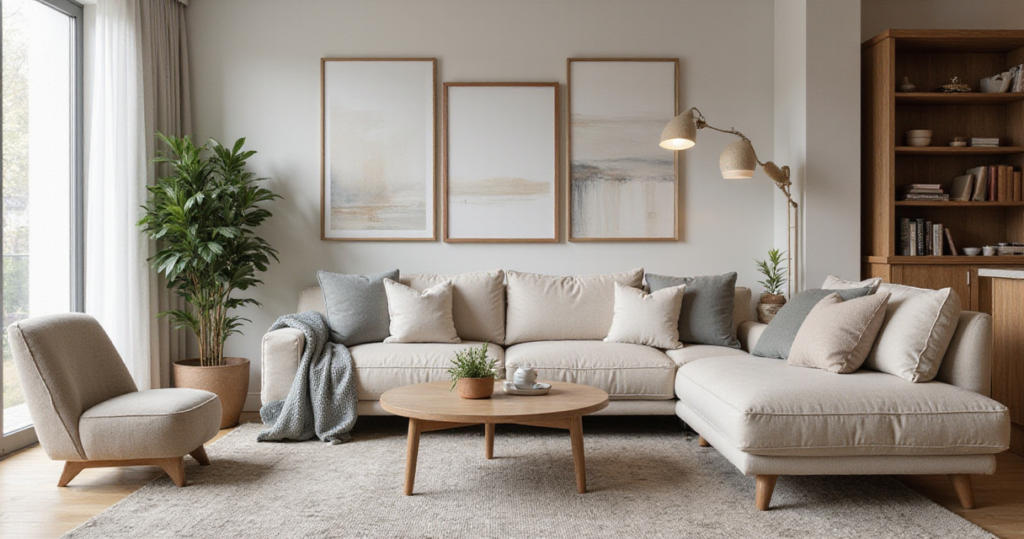The living room interior is more than just a collection of furniture – it’s the heart of your home where memories are created, conversations flow, and your personal style shines through. As someone who has spent years blending Vietnamese design principles with European modernism, I’ve found that the most captivating spaces achieve a delicate balance between functionality and beauty, tradition and innovation.
Whether you’re starting fresh in a new home or refreshing your current living room interior, the process can feel overwhelming. With countless decisions about layout, furniture, colors, and accessories, where do you begin? I’ve distilled years of experience into 19 essential principles that will guide you through creating a space that not only looks stunning but feels authentically yours. These aren’t fleeting trends but timeless concepts that will serve your space for years to come.
The inspiration for this collection of principles struck when I realized how many living rooms feel disconnected – beautiful perhaps, but lacking soul or functionality. Let’s change that together.
1. Optimize Your Layout for Flow and Function
Before selecting a single piece of furniture, consider how energy will move through your living room interior. A well-designed layout ensures natural pathways between seating areas and to entry points, preventing awkward bottlenecks that disrupt the room’s harmony. Start by identifying your primary activities – Is this space primarily for conversation? Television watching? Reading? Working? Your honest assessment will determine furniture needs and placement.
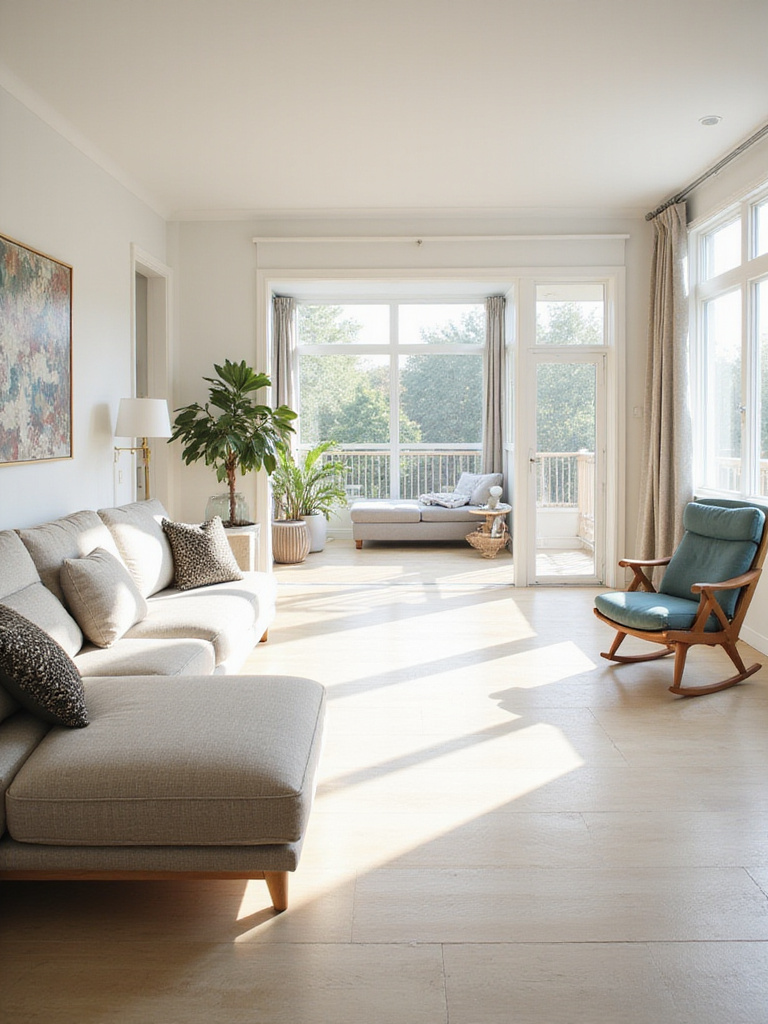
Common layout mistakes include pushing all furniture against walls (creating a “waiting room” effect) or blocking natural pathways with oversized pieces. Instead, create conversation areas where people can comfortably interact, ensuring seats are no more than 8 feet apart. Leave at least 30-36 inches for major walkways and consider how the room connects to adjacent spaces.
The magic of this piece lies in its foundation – before selecting colors or accessories, create a scaled floor plan. Use paper templates of furniture to experiment with different arrangements, focusing on both function and balance. Once your layout feels intuitive, you’re ready to build upon this essential framework.
2. Craft a Harmonious Color Palette
Color creates the emotional foundation of your living room interior, influencing everything from perceived temperature to spatial dimensions. Rather than following fleeting trends, consider the psychological impact of your palette – blues and greens create calm, while warm tones like terracotta and amber foster intimacy. The traditional 60-30-10 rule offers a reliable framework: 60% dominant color (typically walls), 30% secondary color (larger furniture), and 10% accent colors (accessories and smaller elements).
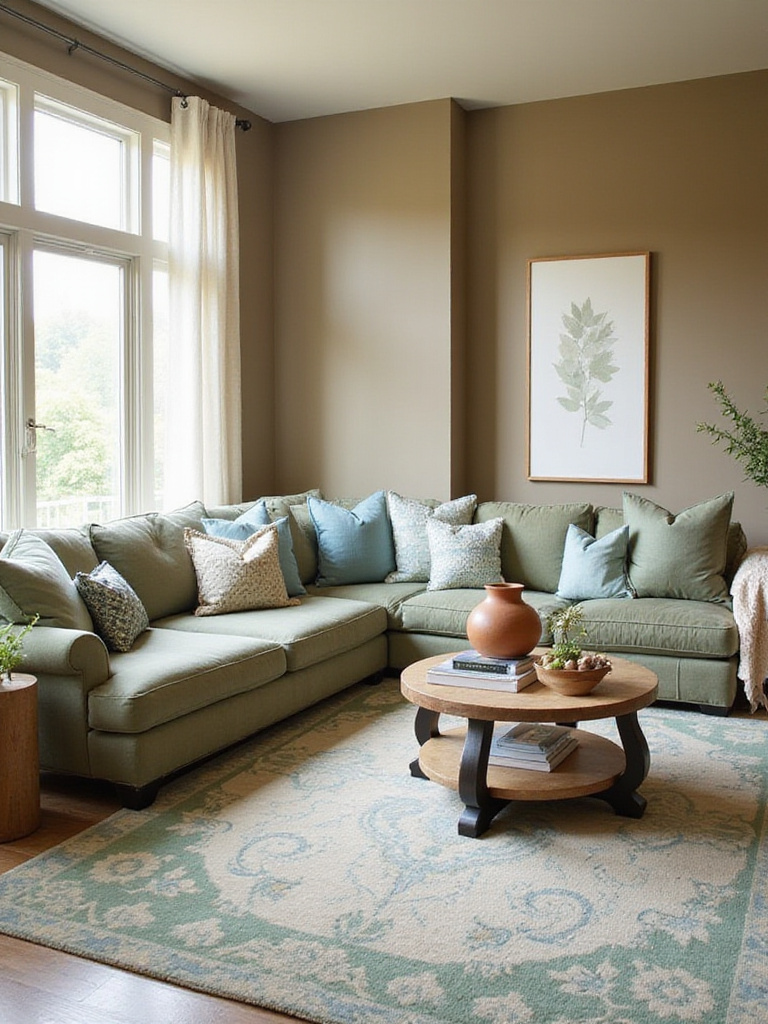
Instead of starting from scratch, draw inspiration from something you love – perhaps a treasured artwork, a handwoven textile, or even the view from your window. Nature provides perfectly balanced color combinations that feel inherently harmonious. Test paint samples on different walls and observe them throughout the day, as natural light dramatically transforms how colors appear.
Running your hand across this material reveals the importance of considering texture alongside color. A monochromatic scheme with varied textures feels rich and nuanced, while even bold color combinations become more sophisticated when unified through consistent textural elements. With your color direction established, we can turn to how light will enhance these choices.
3. Master Layered Lighting for Ambience
The craftsmanship in this collection tells a story of how thoughtful lighting transforms a living room interior from flat to dimensional. Effective lighting combines three essential layers: ambient lighting for overall illumination, task lighting for specific activities, and accent lighting to highlight architectural features or art. This layered approach allows you to adjust the mood throughout the day and for different activities.

Beyond function, lighting shapes atmosphere. Consider how light fixtures themselves contribute to your design narrative – a sculptural pendant makes a statement, while recessed lights disappear into architecture. The quality of light matters too; warm-toned bulbs (2700-3000K) create intimacy, while cooler temperatures feel more energizing. Dimmer switches on separate circuits give you precise control over each lighting layer.
The unexpected environmental benefit comes from strategic lighting that reduces overall energy consumption while improving ambiance. Install ambient lighting first, then identify activity zones (reading nooks, conversation areas) that need focused task lighting. Finally, add accent lights to draw attention to special features, creating depth and visual interest throughout your living room interior.
4. Select Comfortable and Stylish Seating
When clients ask us about balancing style with comfort, I always emphasize that beautiful seating should invite relaxation, not just admiration. Your primary seating piece—whether sofa or sectional—should reflect both your aesthetic vision and practical needs. Consider seat depth (deeper for lounging, shallower for formal settings), cushion fill (down blends offer softness with support), and durable upholstery appropriate for your lifestyle.
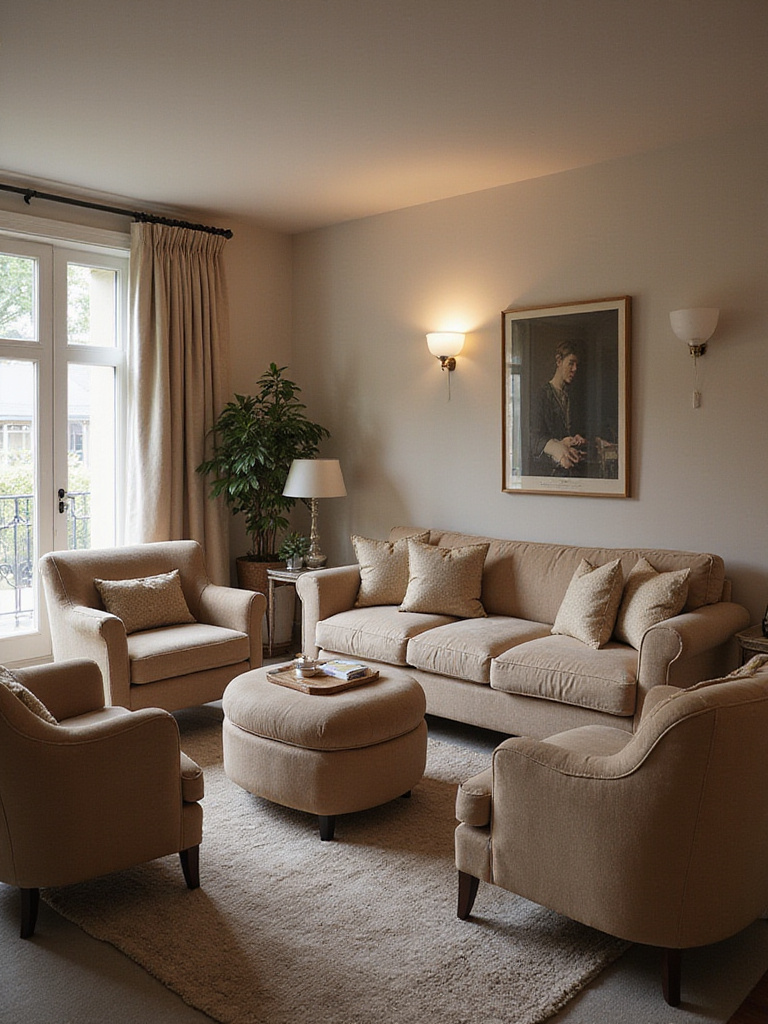
The composition comes together when you incorporate varied seating types. Beyond your main sofa, include:
- Individual armchairs for flexibility and visual interest
- Occasional chairs that can be pulled into conversation areas when needed
- Varied heights and profiles to create dynamic energy
“The most beautiful living room interior is one where people naturally want to linger. If your seating doesn’t invite that, reconsider your choices regardless of how stylish they appear.”
The silhouette draws inspiration from how people actually use spaces. Before purchasing, physically test seating whenever possible—sit, recline, and imagine spending hours there. The right pieces should support your body comfortably while complementing your overall design vision. With your seating established, let’s anchor these elements with the perfect central piece.
5. Choose the Perfect coffee table as a Centerpiece
After months of sourcing and curation, I’ve found that the coffee table often becomes the anchor that ties a seating arrangement together. This functional centerpiece should be proportionate to your sofa (ideally about two-thirds its length) and positioned 14-18 inches from seating edges—close enough to reach comfortably but far enough to allow movement. Height matters too; the table surface should be level with or slightly lower than your sofa’s seat cushions.
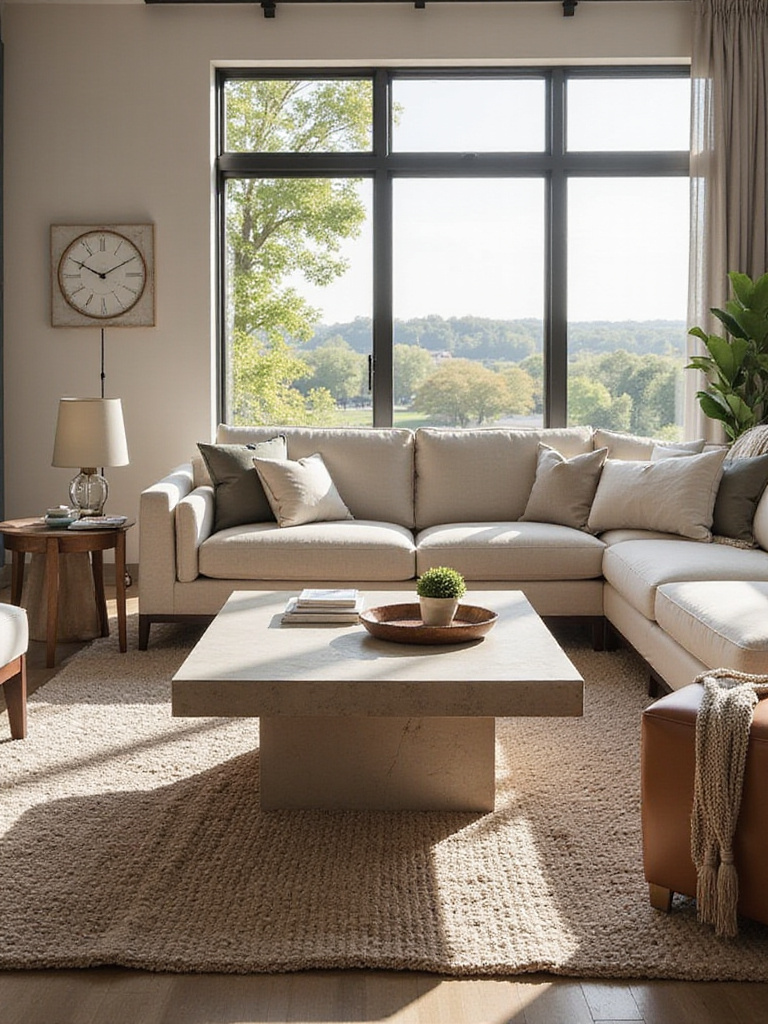
The shape of your coffee table influences both function and flow. Rectangular tables work beautifully with standard sofas, while round or oval shapes soften angular furniture arrangements and improve circulation in tighter spaces. Materials range widely—warm wood adds organic texture, glass creates visual lightness, and mixed materials like marble tops with metal frames introduce sophisticated contrast to your living room interior.
The artisans behind these designs began with the understanding that a coffee table is more than utility—it’s a stage for displaying meaningful objects and supporting daily life. Consider how you’ll use this surface: Will it hold books? Accommodate game nights? Serve as an occasional dining spot? Your honest assessment will guide you to the perfect piece that balances beauty and practicality for your specific needs.
6. Anchor Your Space with an Area Rug
What makes this design special is the way an area rug defines and unifies your seating arrangement, creating a visual “island” within your living room interior. The right rug anchors furniture, absorbs sound, adds warmth underfoot, and introduces texture, pattern, and color. Size is crucial—too small and your arrangement will feel disconnected; too large and the rug loses its defining purpose.
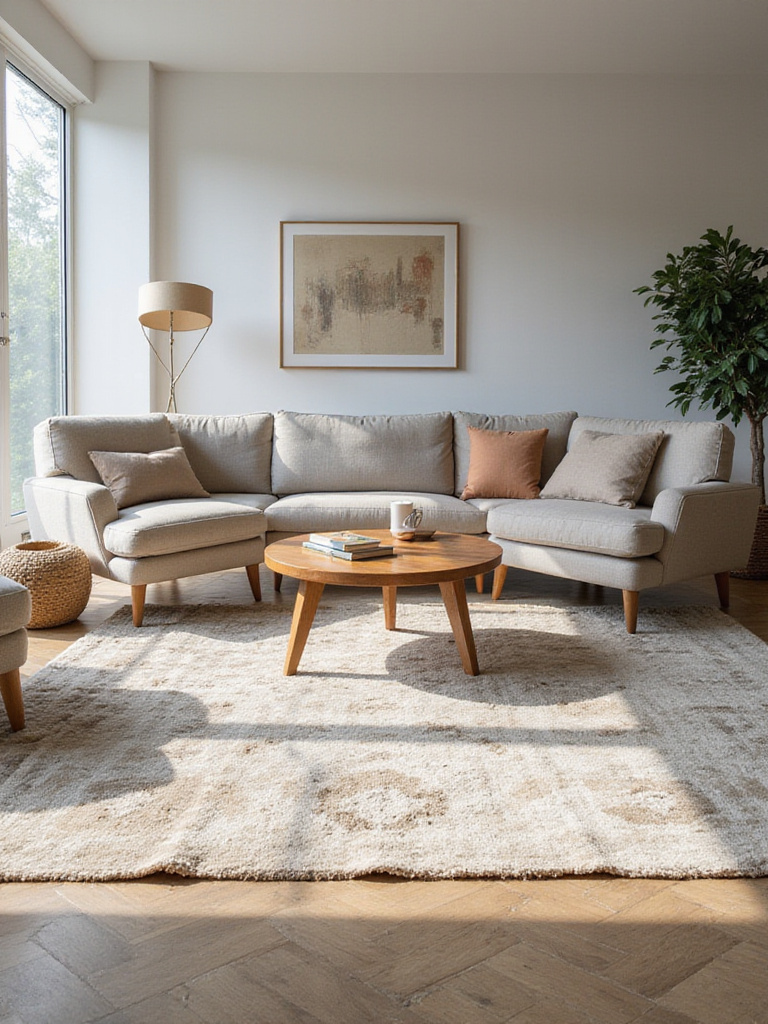
Follow these placement principles for a perfectly anchored space:
- For most living rooms, all front legs of seating should rest on the rug
- In larger spaces, all furniture legs can sit completely on the rug
- Leave 12-18 inches of floor visible between the rug edge and walls
- Ensure the rug extends beyond the coffee table on all sides
The heritage technique gets a contemporary update through today’s performance materials that combine traditional patterns with modern durability. Natural fibers like wool offer inherent stain resistance and longevity, while plant-based options like jute and sisal bring organic texture. Consider layering a smaller statement rug over a larger neutral base for added dimension and interest.
The third-generation workshop where this comes to life understands that an area rug is both practical and emotional—it’s the foundation upon which your living room interior builds its character. With this grounding element in place, we can turn our attention to what draws the eye upward: your wall decor.
7. Curate Captivating Wall Art and Decor
Look closely and you’ll notice the subtle texture of how thoughtfully selected wall art transforms a living room interior from basic to breathtaking. Art creates focal points, expresses personality, and establishes color harmony throughout the space. Rather than choosing pieces merely to fill empty walls, curate art that resonates with you emotionally—pieces that tell stories, evoke memories, or simply bring you joy when you see them.
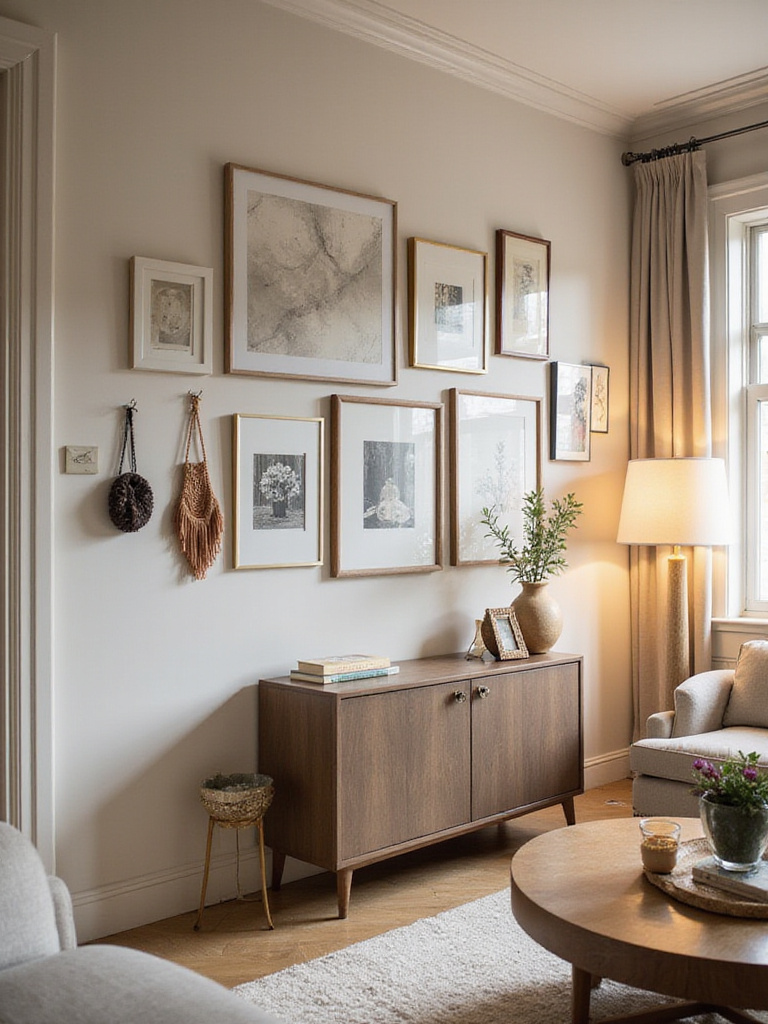
Scale and placement dramatically impact how art functions in your space. A single large piece creates a powerful statement above a sofa or fireplace, while a carefully composed gallery wall adds dynamic energy. When hanging art, position the center point at approximately 57-60 inches from the floor (standard eye level), unless placing above furniture—then allow 6-8 inches between the furniture top and the frame bottom. Consider unexpected mediums beyond traditional paintings:
- Textile art adds dimensional texture
- Sculptural pieces create dramatic shadows
- Mirrors reflect light while functioning as art
- Photography brings personal narrative
The revival of this classic form comes with a twist when you mix different mediums, frames, and subjects while maintaining a cohesive thread—perhaps through color palette, theme, or frame style. Your wall decor should evolve over time rather than being purchased all at once, allowing your collection to grow authentically with your experiences.
For those worried about maintenance, consider how your wall selections interact with natural light sources. UV-protective glass prevents fading of valuable pieces, while thoughtful placement away from direct sunlight preserves textiles and works on paper. With your walls addressed, let’s frame another crucial vertical element: your windows.
8. Dress Your Windows with the Right Treatments
The design language evolved from traditional patterns that inspired today’s window treatments—essential elements that frame views, filter light, and significantly impact your living room interior’s mood. Window coverings serve multiple functions: privacy control, light management, temperature regulation, and aesthetic enhancement. The perfect treatment balances these practical needs with your design vision.
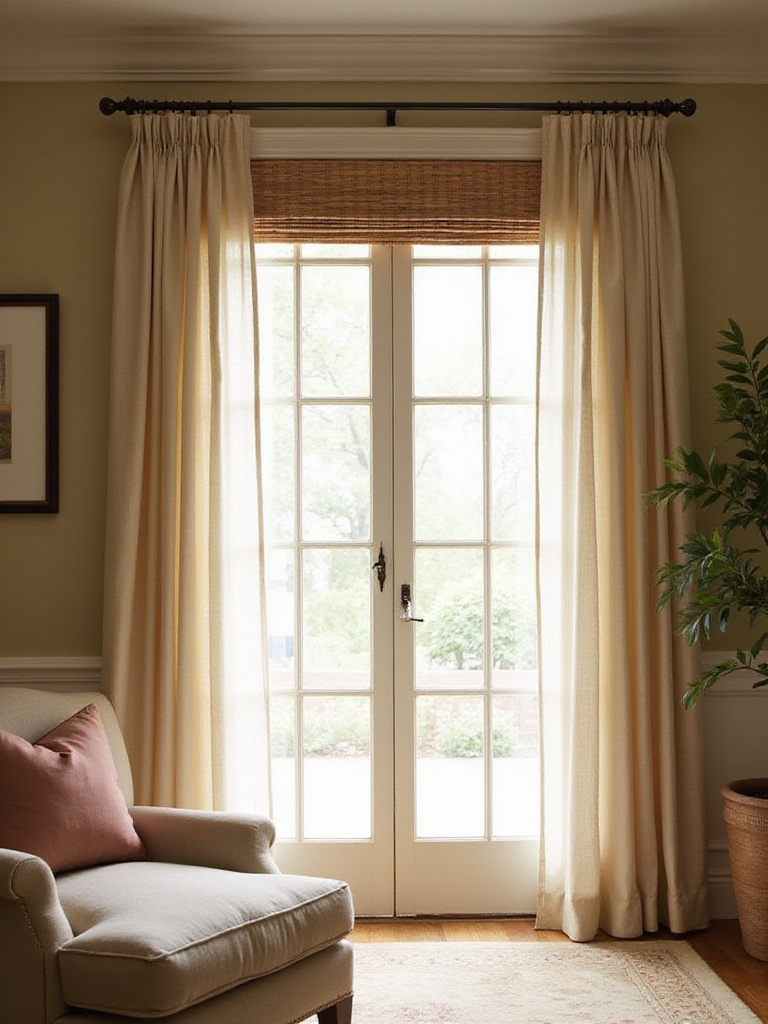
Consider the architecture of your windows and how treatments might enhance their features. Floor-to-ceiling drapes create vertical lines that visually extend ceiling height, while Roman shades offer clean, tailored solutions for smaller windows. Layer treatments for maximum flexibility—perhaps combining sheer curtains for daytime privacy with blackout drapes for evening use. Materials matter tremendously:
- Natural fibers like linen and cotton bring casual elegance
- Velvet adds dramatic luxury and excellent light blocking
- Woven woods introduce organic texture and filtered light
- Performance fabrics offer durability in sun-exposed areas
The sustainable journey of this material involves considering both aesthetics and energy efficiency. Properly fitted window treatments can reduce heat loss in winter and prevent solar gain in summer, potentially lowering energy costs while enhancing comfort. Choose treatments that complement your overall design scheme while addressing the specific needs of each window.
The environmental story behind this piece began with understanding that window treatments are both functional and decorative. Mount curtain rods 4-6 inches above window frames and extend them 8-12 inches beyond the window’s width on each side to make windows appear larger and maximize light when curtains are open. With your windows beautifully framed, let’s add the tactile elements that make a living room interior truly inviting.
9. Layer in Comfort with Pillows and Throws
The styling mistake most people make is treating pillows and throws as afterthoughts, when these textile layers are essential to a living room interior’s comfort and character. These soft accessories invite relaxation, add color and pattern, and can be easily changed to refresh your space seasonally. Think of them as the final layer that transforms furniture from merely functional to genuinely inviting.
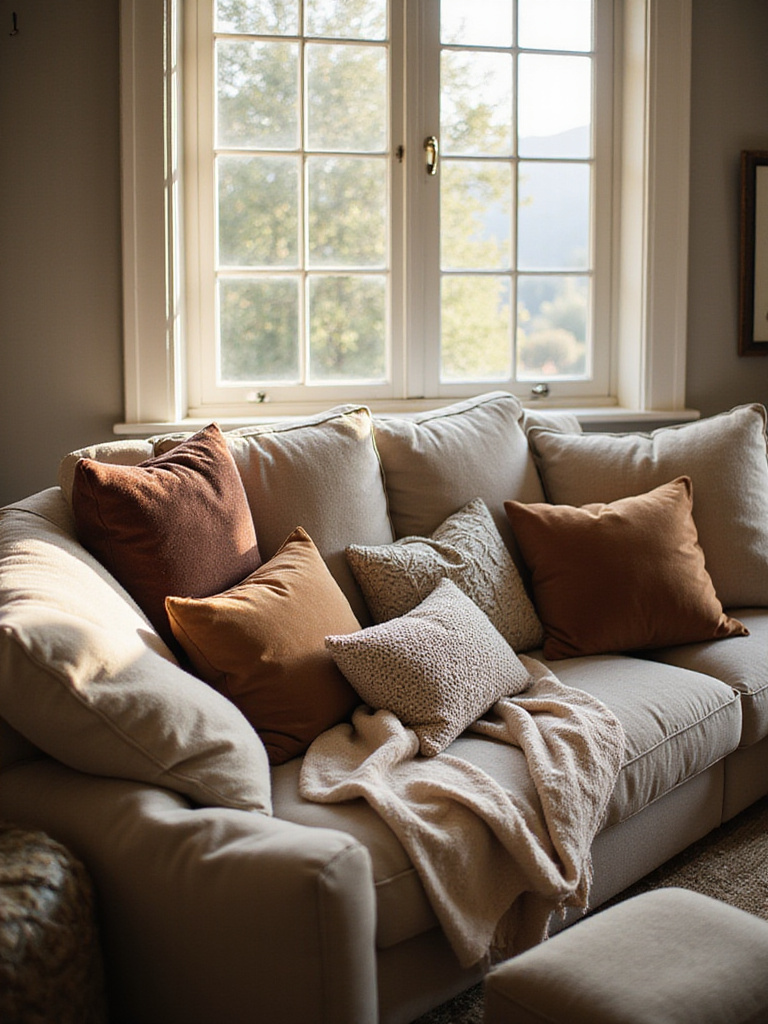
Creating an artful arrangement involves balancing color, pattern, texture, and size. Start with larger pillows (22-24 inches) at the outer corners of your sofa, then layer in medium and smaller sizes toward the center. Vary textures—perhaps contrasting smooth velvet against nubby linen or introducing unexpected elements like embroidery or fringe. For throws, consider both aesthetic and practical qualities:
- Chunky knits add dimensional texture and warmth
- Lightweight gauze or cotton works for warmer climates
- Natural fibers like wool and cashmere offer luxury and longevity
- Varied weights provide options for different seasons
The versatility reveals itself when you pair this with thoughtful placement. Rather than perfectly symmetrical arrangements, try an asymmetrical approach that feels more naturally curated. Allow throws to drape casually over an armrest or the back of a chair—perfectly imperfect positioning creates an inviting, lived-in quality.
The finishing touch that elevates the entire look comes through considering how these soft elements interact with your overall color scheme. They’re perfect opportunities to introduce accent colors or experimental patterns you might hesitate to use on larger pieces. With these comfortable layers in place, let’s introduce another element of life and vitality.
10. Bring Life with Lush Greenery
Many homeowners wonder how to add dimension and vitality to their living room interior without major renovations. The answer often lies in incorporating plants, which bring natural color, organic shapes, and literal life into your space. Beyond aesthetics, plants improve air quality, boost mood, and create a connection to nature that deeply resonates with our biological need for natural elements.
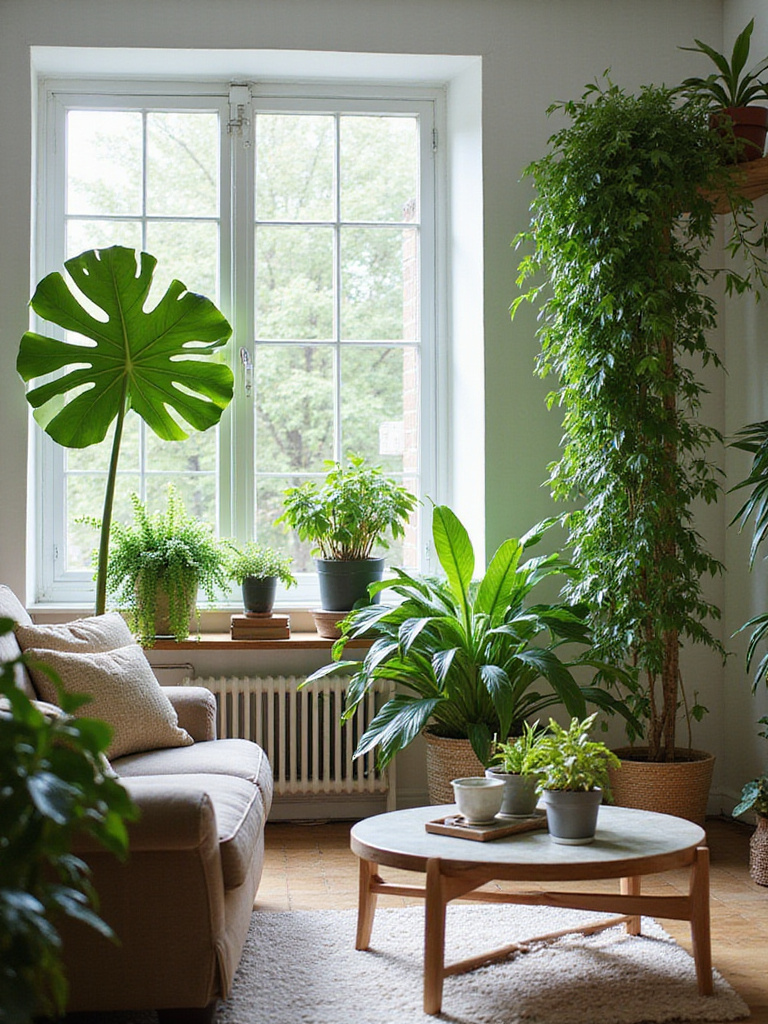
Select plants based on your space’s specific light conditions and your maintenance capacity. For bright, direct light, consider statement plants like fiddle leaf figs or bird of paradise. In medium light, peace lilies and ZZ plants thrive with minimal care. Even low-light corners can support snake plants or pothos varieties. Vary your presentation through:
- Elevated planters that create height variation
- Hanging plants that draw the eye upward
- Clustering several smaller plants for impact
- Statement pots that complement your design scheme
The cultural heritage preserved in each piece includes understanding how plants have been central to home environments across civilizations. Different cultures have long valued specific plants for their symbolic meanings—peace lilies representing tranquility, jade plants suggesting prosperity, and palms symbolizing victory. Consider these cultural narratives when selecting greenery for your living room interior.
The interplay between the colors creates dynamic energy when you position plants thoughtfully throughout your space. Place larger specimens in empty corners to soften architectural lines, use medium plants to fill gaps between furniture, and incorporate small plants on shelves or tables as living accessories. With natural elements integrated, let’s address how to keep your beautiful space organized.
11. Integrate Smart and Stylish Storage
Even in smaller spaces, here’s how this works: thoughtful storage solutions maintain your living room interior’s beauty while accommodating life’s necessities. Without proper storage, even the most stunning design quickly becomes compromised by clutter. The key is integrating storage that serves your specific needs while contributing aesthetically to your overall design vision.
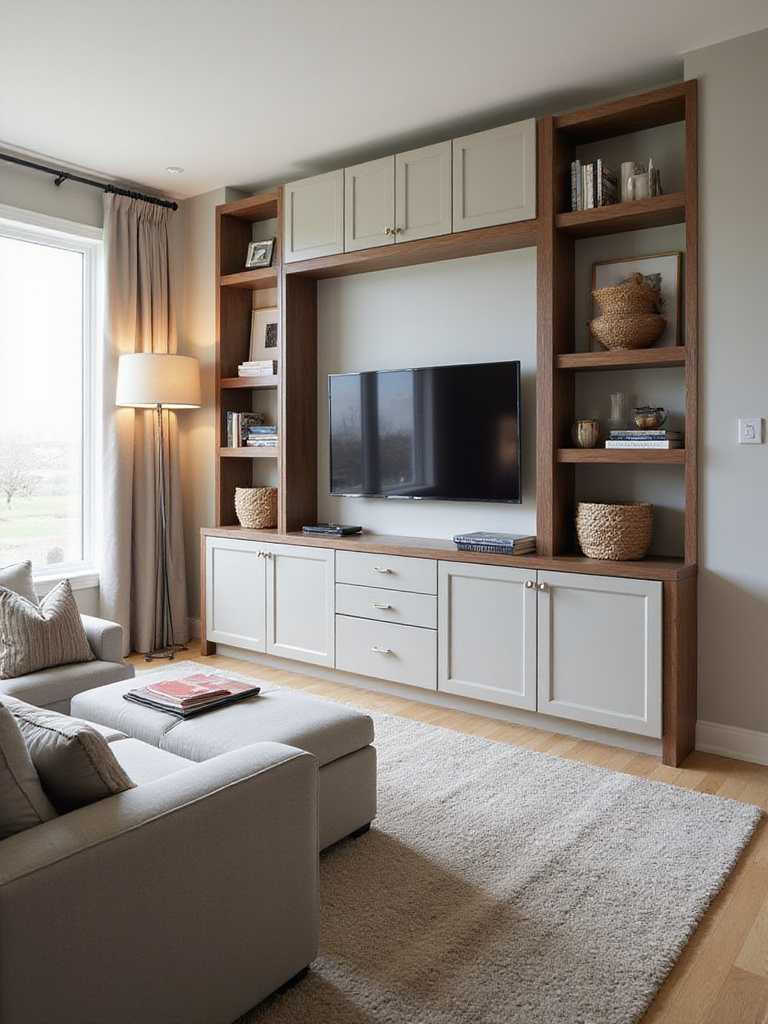
Begin by honestly assessing what needs to be stored in your living room—media equipment, children’s toys, books, games, or hobby supplies. Then explore solutions that address these specific needs:
- Built-in cabinetry flanking architectural features
- Floating shelves for displaying beautiful objects while providing storage
- Multifunctional furniture like storage ottomans or side tables with drawers
- Decorative baskets that corral smaller items while adding texture
The traditional methods used result in storage that feels intentional rather than apologetic. Consider the visual weight of storage pieces—lighter, open shelving creates airiness, while substantial closed storage grounds the space. The most successful living room interior designs incorporate a mix of open and closed storage, displaying cherished items while concealing necessary but less attractive belongings.
The maker’s journey from apprentice to master influenced how we think about integrating storage seamlessly. Rather than allowing storage to dominate, it should support your lifestyle quietly and efficiently. With clutter controlled, we can focus on the elements that make your space uniquely yours.
12. Infuse Personality with Personal Touches
If you’ve struggled with similar rooms before that felt beautiful but soulless, the missing ingredient was likely personal expression. A living room interior without personal touches often resembles a hotel lobby—pleasant but impersonal. The elements that tell your story transform a well-designed space into a home that resonates with authentic character and emotional connection.
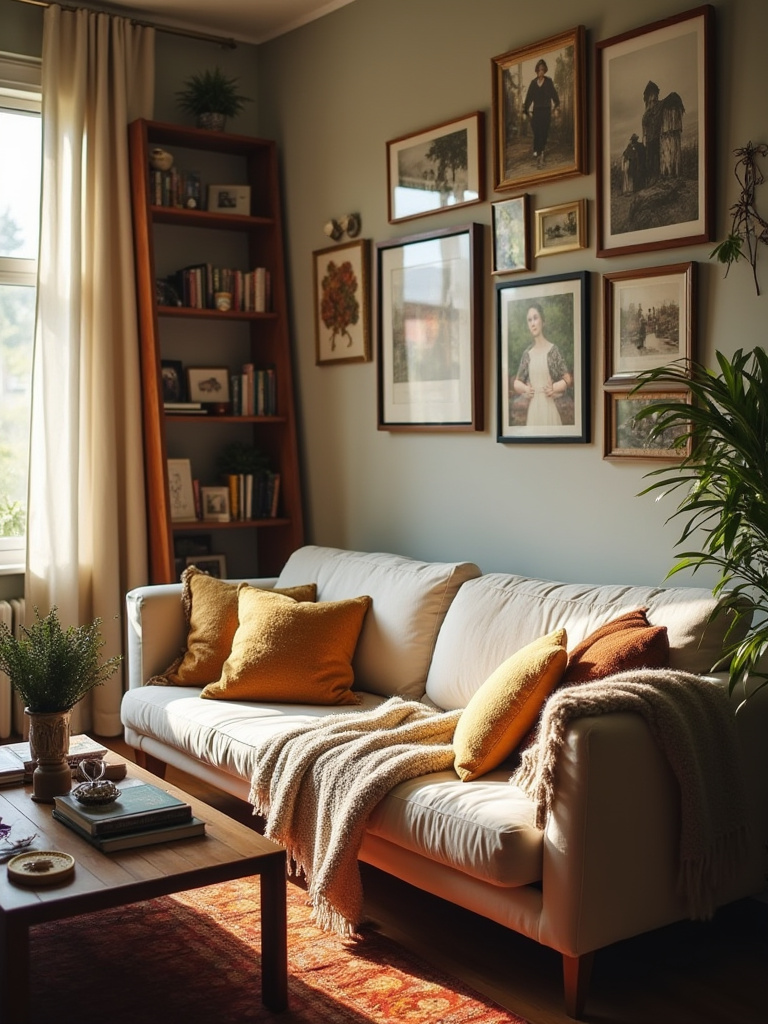
Personal touches might include:
- Family photographs displayed in cohesive frames
- Souvenirs from meaningful travels
- Books that reflect your interests and passions
- Artwork created by family members or local artists
- Collections that showcase your unique fascinations
- Inherited pieces that carry family history
“The most compelling Living Room Interiors balance design principles with personal expression—creating spaces that couldn’t possibly belong to anyone else.”
The visual weight balances perfectly when personal items are thoughtfully integrated rather than scattered randomly. Create intentional vignettes that group related objects, use shadow boxes to display smaller collections, and rotate seasonal or sentimental items to keep your space feeling fresh while maintaining its personal connection.
Unlike mass-produced alternatives, this technique allows your living room interior to evolve naturally over time, accumulating layers of meaning and memory. These personal elements often become natural conversation starters, inviting guests to learn more about your journeys, interests, and values. With your personality established in the space, let’s create a strong visual anchor.
13. Create a Striking Focal Point
The artisan collective that creates these pieces understands that every compelling living room interior benefits from a dominant visual element that draws the eye and organizes the space around it. A focal point provides direction and purpose, preventing the room from feeling scattered or overwhelming. It becomes the natural starting point from which the rest of your design flows.
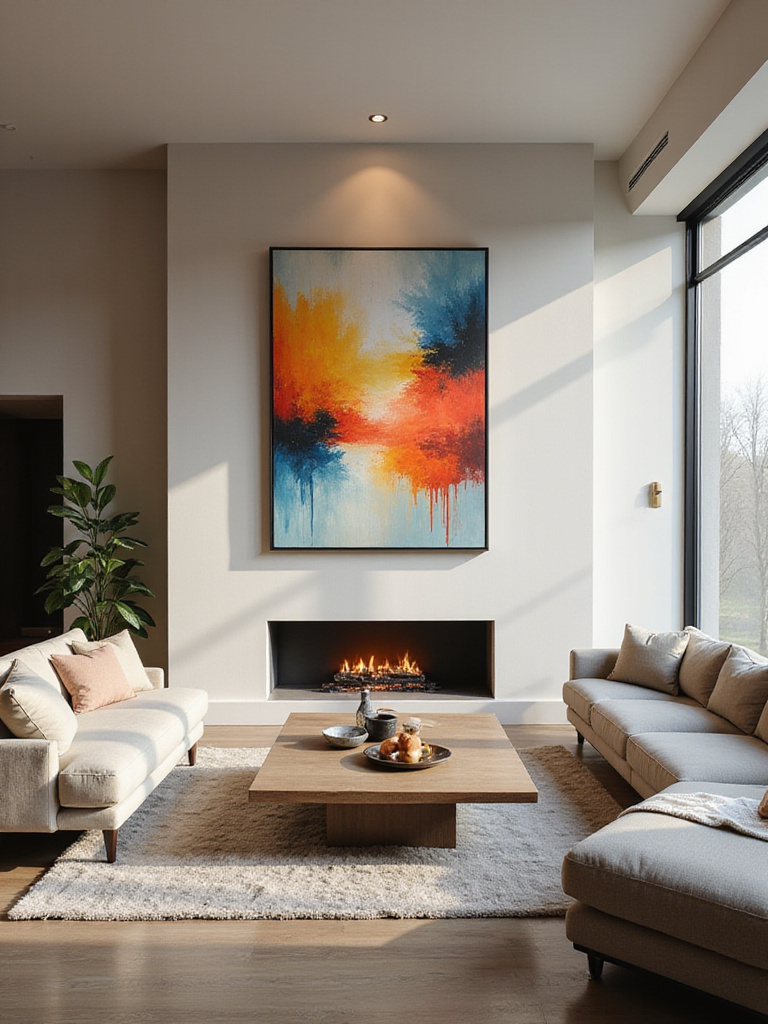
Some living rooms have natural focal points—a fireplace, stunning view, or architectural feature. If yours doesn’t, you can create one through:
- An oversized piece of art on a prominent wall
- A dramatic light fixture that commands attention
- A statement furniture piece in a distinctive shape or vibrant color
- A media wall with thoughtful styling around the television
- A large mirror that reflects light and expands the space
For those hesitant about bold patterns, a focal point allows you to introduce visual interest in a controlled way. The surrounding elements can be more restrained, creating a balanced composition that feels intentional rather than chaotic. The contrast between your focal point and supporting elements creates the dynamic tension that makes a living room interior visually compelling.
When your existing decor doesn’t seem to coordinate, establishing a clear focal point often provides the organizing principle that brings everything together. Ensure your furniture arrangement acknowledges and faces this focal point when appropriate, reinforcing its importance in the space. With this anchor established, we can explore how texture adds another dimension to your design.
14. Play with Texture for Depth and Interest
The designer’s secret here is understanding that texture is the often-overlooked element that transforms a flat, two-dimensional living room interior into a rich, multisensory experience. While color and pattern create visual interest, texture engages our sense of touch (even if just visually), adding depth and dimension that makes a space feel complete. Without textural variation, even the most beautiful room can feel sterile and uninviting.
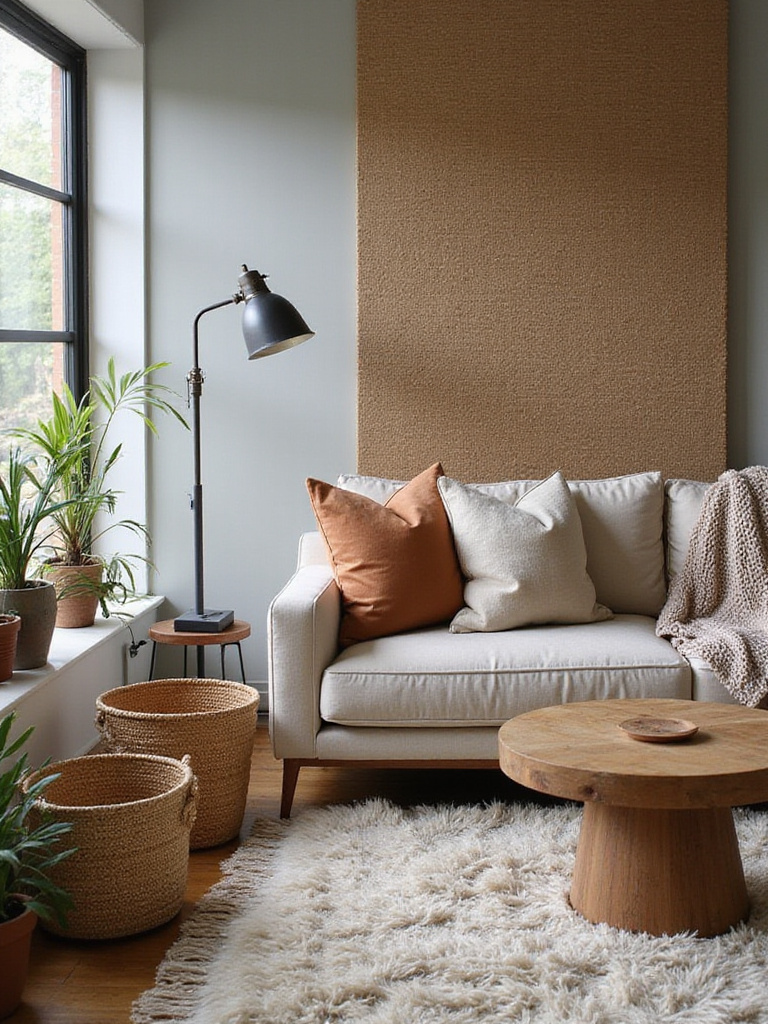
Create a textural landscape by incorporating contrasting surfaces throughout your space:
- Soft elements: velvet pillows, bouclé upholstery, faux fur throws
- Rough textures: natural fiber rugs, raw wood, handmade ceramics
- Smooth surfaces: glass, polished stone, sleek metals
- Woven materials: rattan, cane, macramé, loosely woven textiles
The unexpected pairing that always works is combining opposite textures within a cohesive color palette. This creates visual tension and interest while maintaining harmony. For example, a sleek leather sofa becomes more inviting with nubby throw pillows, while a plush velvet chair gains sophistication next to a polished metal side table.
Beyond the obvious placement, consider using this for creating textural focal points through contrast. A rough stone fireplace surround against smooth painted walls, or a heavily textured wall hanging above a sleek console creates compelling visual interest in your living room interior. With these tactile elements in place, let’s consider how to maximize your space, regardless of its size.
15. Ensure Furniture Scale and Proportion are Right
Professional stylists approach this by first understanding that properly scaled furniture forms the foundation of any successful living room interior. Scale refers to how furniture size relates to the room dimensions, while proportion addresses how pieces relate to each other. When these relationships are harmonious, the room feels balanced and comfortable; when they’re off, even beautiful pieces can make a space feel awkward or uncomfortable.
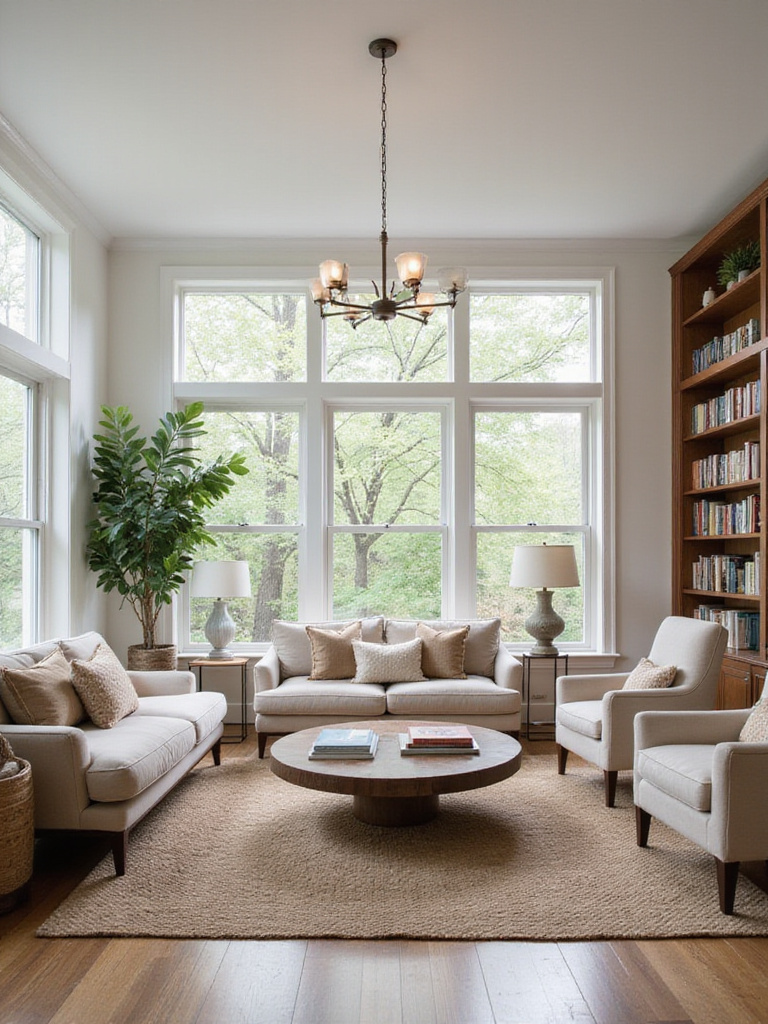
For appropriate scale, consider these guidelines:
- Allow at least 30-36 inches for main walkways
- Maintain 14-18 inches between the sofa and coffee table
- Ensure at least 3.5 feet between seating pieces for conversation areas
- Leave 12-18 inches of “breathing room” between large furniture and walls
The quality becomes evident after years of use when furniture is properly proportioned. A sectional that’s too large for a room will always feel cramped, while undersized pieces in a large space create a disconnected feeling. The relationship between pieces matters too—a delicate side table next to a substantial sofa feels unbalanced, while matching the visual weight creates harmony.
While trendy, this element has staying power because it’s based on human ergonomics and spatial perception. Before purchasing, create a scaled floor plan and outline furniture dimensions with painter’s tape on your floor. This simple step prevents costly mistakes and ensures your living room interior feels naturally balanced. With properly scaled furniture in place, let’s consider how to add the finishing decorative elements.
16. Accessorize Thoughtfully, Not Excessively
As morning light filters through, the texture creates subtle shadows across thoughtfully placed accessories—the final layer that brings personality to your living room interior. Accessories are the equivalent of jewelry for your space, adding sparkle and character, but like jewelry, restraint often yields the most elegant results. The goal is curated abundance rather than cluttered excess.
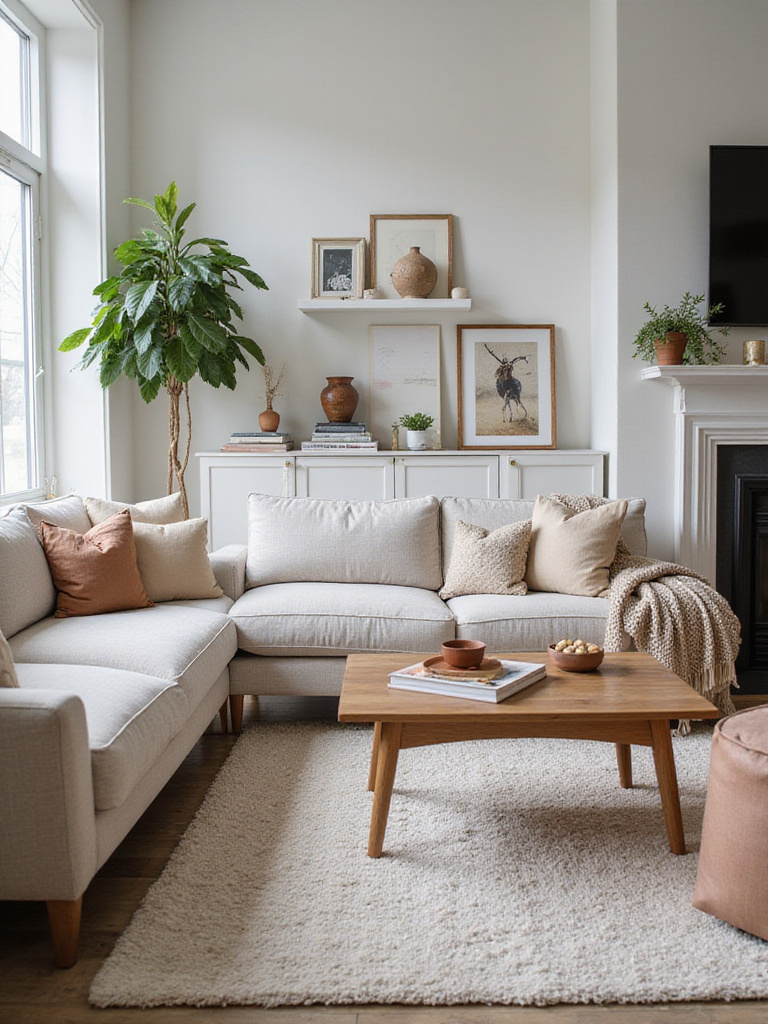
Successful accessorizing follows several principles:
- The rule of odd numbers (groups of 3 or 5 objects often look more dynamic than even numbers)
- Varying heights and shapes within groupings
- Cohesive color palette that ties to your overall scheme
- Negative space between objects to allow each piece to shine
The material sourcing makes all the difference in how accessories contribute to your space. Choose fewer, higher-quality pieces that have meaning or visual impact rather than many inexpensive items that create visual noise. Consider the story behind each piece—handcrafted ceramics, objects collected during travels, or artisanal creations bring authenticity that mass-produced decorations often lack.
The evolution of this trend reflects broader cultural shifts toward intentional consumption and away from excessive decoration. Edit ruthlessly, removing anything that doesn’t serve either a functional purpose or bring genuine joy. This disciplined approach creates a living room interior that feels curated rather than crowded. With accessories thoughtfully placed, let’s explore how mirrors can enhance your space.
17. Expand Your Space with Strategic Mirrors
The designer’s attention to detail shows in how strategically placed mirrors can transform a living room interior, making it feel more spacious, brighter, and more dynamic. Mirrors perform multiple functions simultaneously—they reflect light, expand visual space, and serve as decorative elements in their own right. Their transformative power makes them essential tools in any design toolkit.
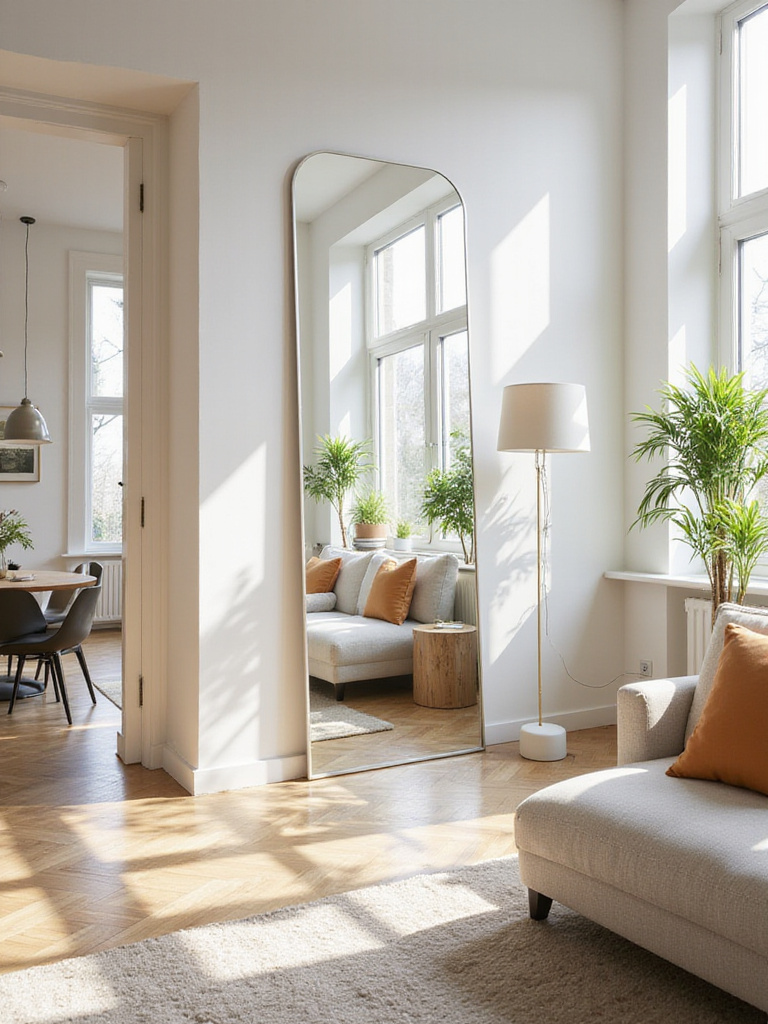
Position mirrors thoughtfully to maximize their impact:
- Across from windows to bounce natural light deeper into the room
- In narrow hallways or transitions to create a sense of width
- Above console tables to create vignettes with depth
- As a focal point when framed dramatically or in unusual shapes
- In groupings of smaller mirrors for artistic effect
The challenge of awkward spaces becomes easier when you use mirrors to visually correct spatial issues. A tall, narrow mirror can make a squat room feel higher, while a horizontal mirror expands perceived width. Consider the frame as an important design element—ornate frames add traditional elegance, while sleek frameless mirrors create contemporary simplicity.
For those worried about maintenance, position mirrors where they won’t constantly show fingerprints or require frequent cleaning. Also consider what the mirror will reflect—ideally, it should capture an attractive view, artwork, or architectural feature rather than clutter or blank walls. With this understanding of reflective surfaces, let’s explore another versatile element for your living room interior.
18. Add Flexible Seating and Style with Ottomans
This chameleon-like piece adapts to various styles by serving multiple functions in your living room interior. Ottomans are design superheroes—they can be footrests, coffee tables, extra seating, storage units, and style statements all in one versatile package. Their adaptability makes them particularly valuable in spaces that need to accommodate various activities or group sizes.
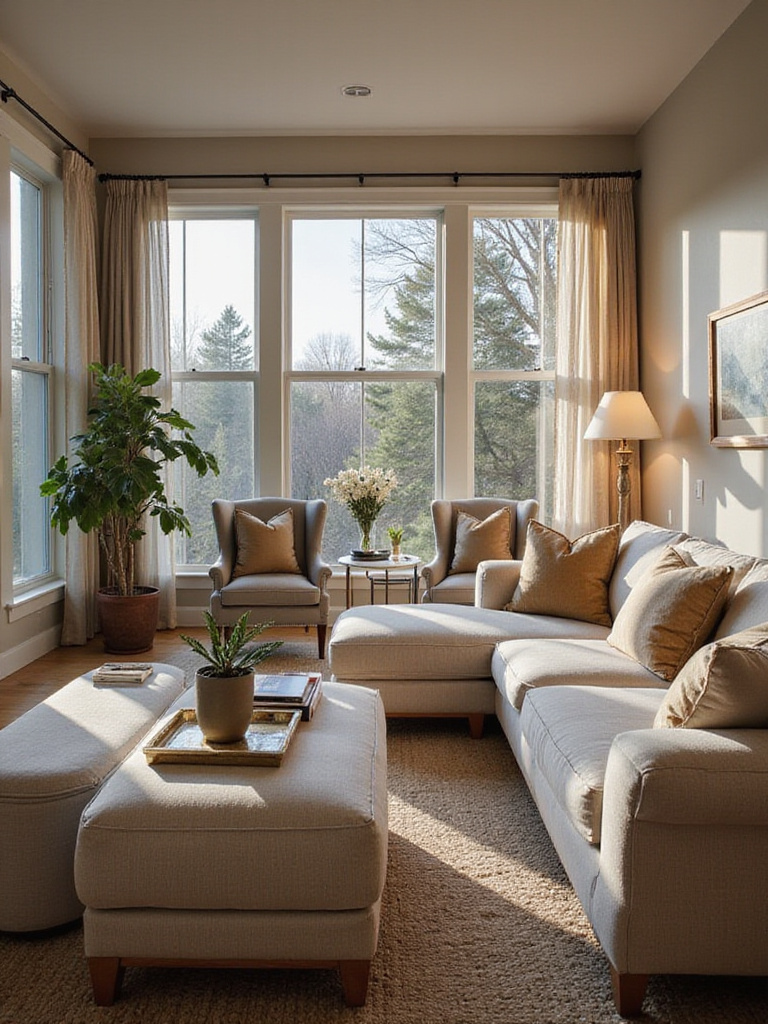
When selecting an ottoman, consider these versatile applications:
- Top with a tray to create an instant coffee table
- Choose storage ottomans to hide throws, magazines, or games
- Use in pairs for symmetrical arrangements or flexibility
- Select contrasting upholstery to add a pop of color or pattern
- Consider unusual shapes (hexagons, ovals) for visual interest
The investment value comes from the exceptional versatility ottomans provide. A single piece that serves multiple functions offers tremendous value, especially in smaller living room interiors where space efficiency is crucial. Materials range from luxurious leather and velvet to practical performance fabrics, allowing you to balance beauty with the realities of your lifestyle.
Picture the warmth of evening conversations around a centrally placed ottoman that brings people together in a circular arrangement. Unlike single-purpose decor, this adapts to your changing needs—from casual family movie nights with feet up to elegant gatherings where extra seating is needed. With this flexible element in place, let’s consider how to organize your overall living room interior for maximum functionality.
19. Define Zones or Maximize a Small Space
The unexpected color story emerging this year celebrates how thoughtfully defined zones can transform even challenging living room interiors into highly functional, beautiful spaces. Whether you have an expansive open floor plan that needs structure or a compact space requiring efficiency, zone definition creates purpose and improves flow throughout your living room.
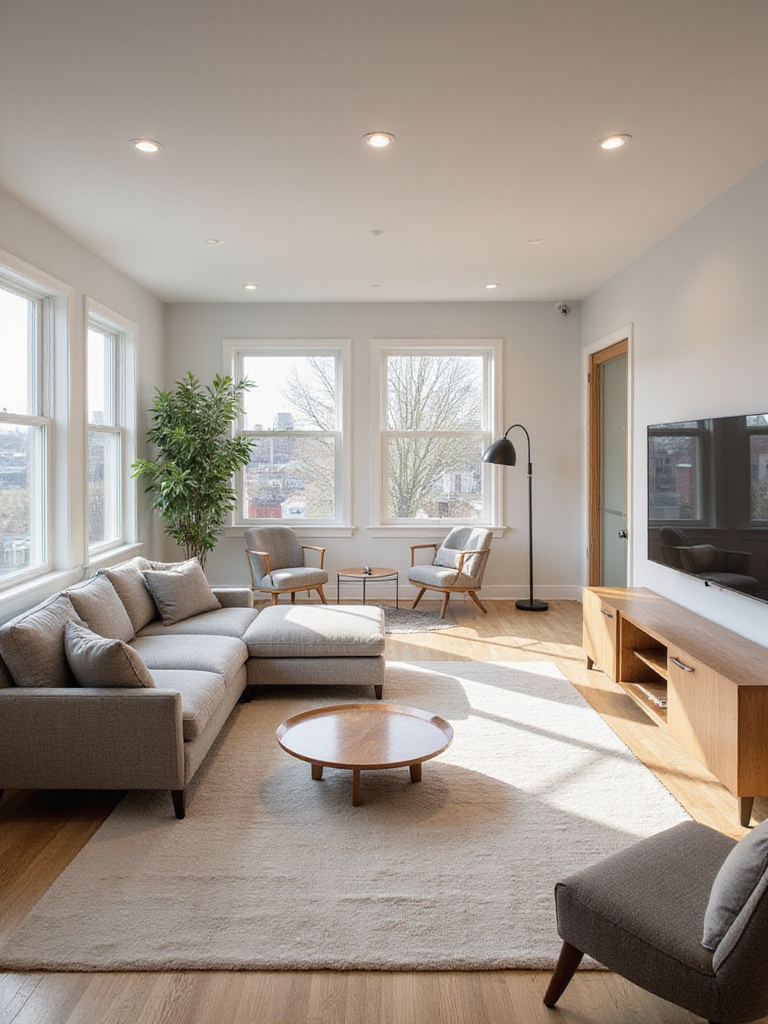
In larger spaces, create distinct zones for different activities:
- Conversation areas with seating arranged for face-to-face interaction
- Media zones oriented toward television viewing
- Reading nooks with adequate lighting and comfortable seating
- Work or hobby spaces with appropriate surfaces and storage
- Transitional areas that connect different zones naturally
The ecological impact matters because well-defined spaces improve efficiency and reduce the need for separate rooms, potentially allowing for smaller overall home footprints. Use visual cues like area rugs, lighting changes, furniture groupings, or even ceiling treatments to delineate zones without physical barriers that would interrupt the open feeling.
The tactile experience changes the entire room’s energy when small spaces are thoughtfully maximized. Embrace multifunctional furniture, utilize vertical space with tall bookshelves or wall-mounted storage, and consider furniture with exposed legs that creates visual lightness. Remember that a well-designed small living room interior often feels more intimate and cozy than an oversized space, embracing its proportions rather than fighting against them.
Conclusion
Creating a living room interior that truly resonates requires balancing timeless design principles with your unique personality and lifestyle needs. These 19 principles aren’t rigid rules but rather a framework to guide your decisions as you craft a space that feels both beautiful and authentically yours. Remember that the most compelling rooms tell stories—of the people who live there, the places they’ve been, and the life they’re creating together.
As you implement these principles, trust your instincts about what feels right for your home. A living room interior should evolve organically over time rather than being completed in a single weekend. Allow yourself to collect meaningful pieces gradually, experiment with arrangements, and adapt as your needs change. The fusion of thoughtful design with personal expression creates spaces with soul—living rooms that welcome, comfort, and inspire both residents and guests.
The journey toward your ideal living room interior isn’t about perfection but about creating a space where life happens beautifully. Start with the principles that resonate most strongly with your current needs, and build from there. Your living room awaits its transformation.
